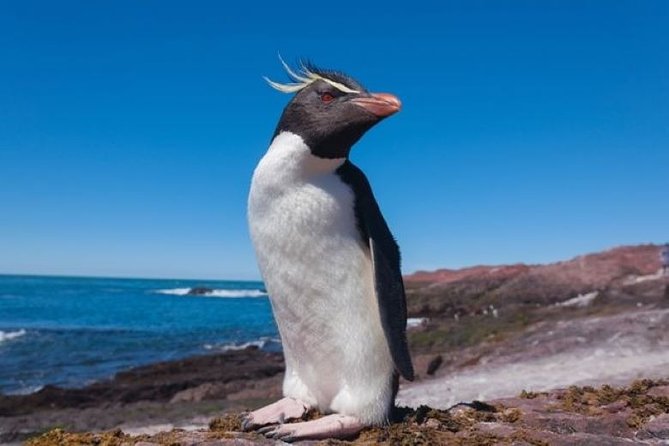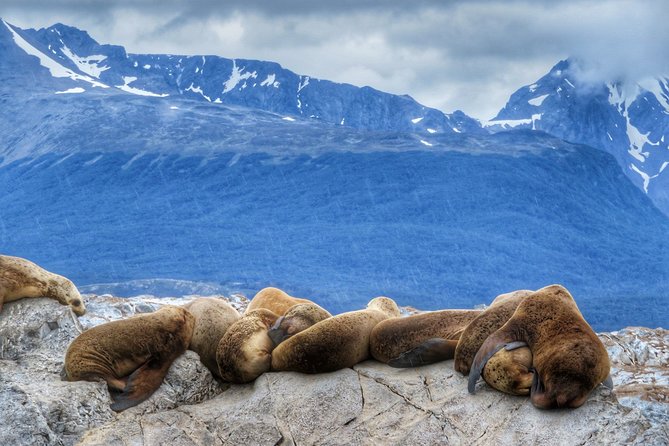Travelers often find themselves awestruck by the sheer magnificence of the Perito Moreno Glacier in Patagonia. The glacier’s captivating beauty and imposing presence are just the beginning of what this region has to offer.
As visitors venture further into the wilderness, they encounter a myriad of adventures waiting to be explored. From epic mountain treks to encounters with unique wildlife, Patagonia promises an experience like no other.
But what hidden gems lie beyond the glacier’s icy embrace? Stay tuned to uncover the mysteries that await in this enchanting land of extremes.
Good To Know
- Explore diverse natural wonders in Patagonia, from towering peaks to vast glaciers.
- Encounter unique wildlife like Andean Condors, Magellanic Penguins, and elusive Pumas.
- Engage in thrilling adventure activities like hiking, biking, climbing, and rafting.
- Enjoy the rich cultural heritage of Patagonia through festivals, music, and local cuisine.
Patagonia’s Natural Wonders

Nestled at the southern tip of South America, Patagonia beckons adventurers with its breathtaking natural wonders waiting to be explored. Patagonia’s geological formations, sculpted by millennia of natural forces, stand as testaments to the Earth’s raw power. Towering peaks, vast glaciers, and deep fjords create a landscape that captivates all who venture here.
On top of that, Patagonia’s environmental conservation efforts are commendable, with initiatives in place to protect its pristine wilderness. Visitors can witness firsthand the harmonious coexistence between humans and nature in this remote and awe-inspiring region. From the rugged beauty of the mountains to the serene beauty of the glaciers, Patagonia’s natural wonders offer a glimpse into a world where conservation and exploration go hand in hand.
Find more activities and experiences we've covered in Buenos Aires.
Unique Wildlife in Patagonia
Amidst the rugged terrain and pristine landscapes of Patagonia, a diverse array of unique wildlife thrives, captivating visitors with its beauty and resilience. From the majestic Andean condors soaring high above the mountains to the playful Magellanic penguins waddling along the shores, Patagonia is a haven for nature enthusiasts. The region’s commitment to wildlife conservation is evident through various ecotourism initiatives that aim to protect and preserve the delicate ecosystems that these creatures call home.
| Unique Wildlife in Patagonia | Description |
|---|---|
| Andean Condor | Majestic birds with impressive wingspans, symbolizing freedom and power. |
| Magellanic Penguin | Playful creatures often seen in large colonies along the coastlines. |
| Guanaco | Wild relatives of llamas, roaming the grasslands in herds. |
| Puma | Elusive big cats, top predators of the region. |
| South Andean Deer | Graceful deer species found in the southern Andes mountains. |
Adventure Activities in Patagonia

Offering adrenaline-pumping experiences amidst Patagonia’s breathtaking landscapes, adventurers can partake in a myriad of thrilling activities that showcase the region’s rugged beauty.
Hiking Expeditions: Traverse through ancient forests, past glaciers, and along crystal-clear lakes on a variety of hiking trails, including the famous Torres del Paine Circuit.
Mountain Biking Trails: Feel the wind in your face as you pedal through diverse terrain, from challenging mountain paths to leisurely routes with panoramic views.
Rock Climbing: Scale magnificent granite cliffs and rocky peaks, with options for all skill levels in stunning locations like El Chaltén.
White-Water Rafting: Conquer the rapids of Patagonia’s rivers for an exhilarating aquatic adventure amidst pristine wilderness.
Embark on these thrilling activities to learn about the heart of Patagonia’s natural wonders.
Patagonia’s Cultural Heritage

Explore the rich tapestry of Patagonia’s cultural heritage, where history intertwines with the vibrant traditions of its indigenous peoples.
Cultural traditions in Patagonia are deeply rooted in the customs of the native Tehuelche, Mapuche, and Selk’nam communities. These traditions are showcased through colorful festivals, traditional music and dance, and intricate handicrafts that reflect the region’s unique identity.
One of the best ways to experience this rich cultural heritage is through sampling the local cuisine, which often includes delicious dishes made from freshly caught seafood, succulent grilled meats, and traditional dishes like the hearty Patagonian lamb stew.
Best Time to Visit Patagonia
Enjoy the enchanting landscapes of Patagonia by discovering the best time to visit this captivating region. When planning your trip, consider the following:
Climate Conditions: The best time to visit Patagonia is during the summer months from November to March when the weather is milder, and the days are longer, allowing for more exploration.
Tourist Attractions: During this time, popular attractions like Torres del Paine National Park in Chile and Los Glaciares National Park in Argentina are easily accessible and offer breathtaking views.
Shoulder Seasons: Consider visiting during the shoulder seasons of spring (September to October) or fall (April to May) for fewer crowds and still pleasant weather.
Winter Adventures: For those seeking a different experience, winter (June to August) offers opportunities for skiing and snowshoeing in the Andes mountains.
Patagonia Packing Essentials
When preparing for your Patagonia adventure, make sure to pack essential items that will enhance your experience in this breathtaking region. Exploring landscapes in Patagonia requires careful packing to ensure comfort and safety.
Here are some packing tips to help you make the most of your trip. Firstly, pack versatile layers to adjust to the ever-changing weather conditions. A waterproof jacket, sturdy hiking boots, and moisture-wicking clothing are must-haves. Don’t forget to bring a daypack for hikes, a refillable water bottle, sunscreen, and insect repellent.
Plus, include a camera to capture the stunning scenery and binoculars for wildlife spotting. With these packing essentials, you’ll be well-prepared to learn about the wonders of Patagonia.
Sustainable Travel Tips for Patagonia
As travelers gear up to explore the captivating landscapes of Patagonia, they can enhance their experience by incorporating sustainable travel tips into their adventure. To ensure a responsible journey, here are some key practices to consider:
Stay in Eco-Friendly Accommodations: Choose lodgings that prioritize sustainability, such as eco-lodges or hotels with green certifications.
Respect the Environment: Follow designated trails, avoid littering, and support local conservation efforts.
Minimize Plastic Use: Carry a reusable water bottle, refuse single-use plastics, and opt for eco-friendly products.
Support Responsible Tourism Practices: Engage with local communities respectfully, buy locally-made souvenirs, and choose tour operators committed to sustainable tourism principles.
Frequently Asked Questions
What Is the Local Cuisine Like in Patagonia?
Local cuisine in Patagonia showcases a blend of traditional flavors and innovative dishes. Rich in local ingredients, food markets offer a taste of the region’s fusion cuisine. Culinary classes provide an immersive experience to explore Patagonia’s gastronomic delights.
Are There Any Traditional Festivals or Events That Take Place in Patagonia?
Traditional celebrations and cultural events enrich Patagonia’s vibrant tapestry. Local festivals like the Fiesta Nacional del Lúpulo and Semana de la Aventura showcase the region’s heritage and spirit. Immerse in the vibrant rhythms of Patagonia’s festivities.
Can Visitors Interact With Indigenous Communities in Patagonia?
Visitors can engage in cultural exchanges and authentic experiences by interacting with indigenous communities in Patagonia. This form of community engagement promotes ethical tourism, offering a unique opportunity for travelers to connect with local traditions and heritage.
Are There Any Restrictions on Photography in Certain Areas of Patagonia?
Photography regulations in Patagonia aim to preserve the stunning scenic views. Certain areas may have restrictions to maintain the natural beauty. Visitors should respect these guidelines to safeguard the environment and enjoy the landscape responsibly.
How Is the Internet and Cell Phone Coverage in Remote Parts of Patagonia?
In remote parts of Patagonia, satellite communication is crucial due to limited coverage. Connectivity faces challenges in these rugged terrains. Travelers may experience intermittent service, making it advisable to be prepared for potential communication disruptions.
The Sum Up
Embark on the journey of a lifetime and discover the wonders of Patagonia. From the majestic mountains to the unique wildlife, this region offers endless opportunities for adventure and exploration.
Enjoy the rich culture and pristine wilderness of Patagonia, and create memories that will last a lifetime.
Pack your bags, follow the call of the wild, and experience the magic of this remote and captivating destination. Patagonia awaits, ready to awe and inspire you.
More Tour Reviews in Buenos Aires
Looking for something different? Other Buenos Aires activities we've written about
- 3 Best 3 Day Tours In Buenos Aires
- 7 Best Shopping Tours In Buenos Aires
- 25 Best Workshops And Classes In Buenos Aires
- 20 Best Historical Tours In Buenos Aires
- 25 Best Tours In Buenos Aires
- 10 Best 2 Day Tours In Buenos Aires
- 2 Best 4 Day Tours In Buenos Aires
- 4 Best Private Driver Services In Santa Ana
- 20 Best Airport Transfers In Buenos Aires
- 20 Best Private Driver Services In Buenos Aires
- 19 Best Photography Experiences In Buenos Aires
- 20 Best Full-Day Tours In Buenos Aires
